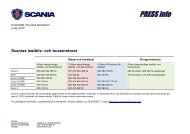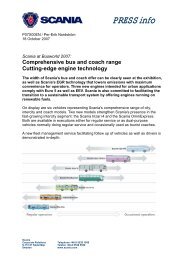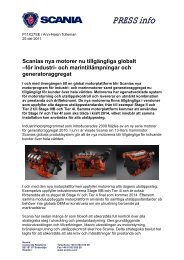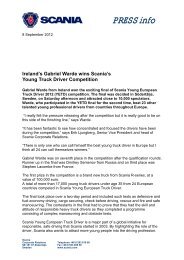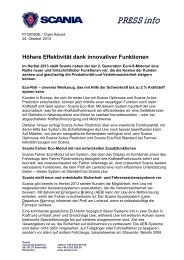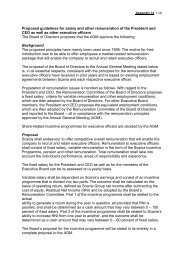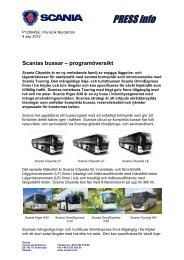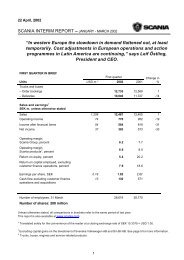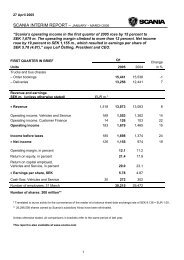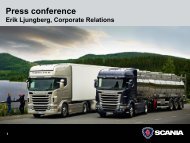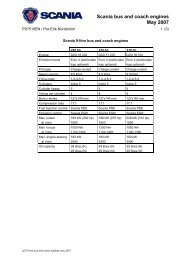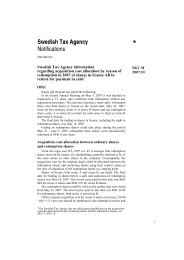Scania Annual Report 2011
Scania Annual Report 2011
Scania Annual Report 2011
You also want an ePaper? Increase the reach of your titles
YUMPU automatically turns print PDFs into web optimized ePapers that Google loves.
91<br />
Employee benefits<br />
Within the <strong>Scania</strong> Group, there are a number of both defined contribution<br />
and defined benefit pension and similar plans, some of which<br />
have assets that are managed by special foundations, funds or the<br />
equivalent.<br />
The plans include retirement pensions, survivor pensions, health<br />
care and severance pay. These are financed mainly by provisions to<br />
account s and partially via premium payments. Plans in which <strong>Scania</strong><br />
only pays fixed contributions and has no obligation to pay additional<br />
contributions if the assets of the plan are insufficient to pay all compensation<br />
to the employee are classified as defined contribution plans.<br />
The Group’s expenditures for defined contribution plans are recognised<br />
as an expense during the period when the employees render<br />
the services in question. Defined benefit plans are all plans that are<br />
not classified as defined contribution. These are calculated accordin g<br />
to the “Projected Unit Credit Method”, for the purpose of fixing the<br />
presen t value of the obligations for each plan. Calculations are performed<br />
every year and are based on actuarial assumptions that are set<br />
on the closing day. The obligations are carried at the present value of<br />
expected disbursements, taking into account inflation, expected future<br />
pay increases and using a discount rate equivalent to the interest rate<br />
on top-rated corporate or government bonds with a remaining maturity<br />
corresponding to the obligations in question.<br />
The interest rate on top-quality corporate bonds is used in those<br />
countries where there is a functioning market for such bonds. In other<br />
countries, the interest rate on government bonds is used instead. For<br />
plans that are funded, the fair value of the plan assets is subtracted<br />
from the estimated present value of the obligation. Changes in pensio n<br />
obligations and managed assets, respectively, due to changes in<br />
actuarial assumptions or adjustments in actuarial parameters based<br />
on outcomes are recognised under “Other comprehensive income”<br />
(“actuarial gains and losses”) and do not affect net income.<br />
In the case of some of the Group’s defined-benefit multi-employer<br />
plans, sufficient information cannot be obtained to calculate <strong>Scania</strong>’s<br />
share in these plans. They have thus been accounted for as definedcontribution.<br />
For <strong>Scania</strong>, this applies to the Dutch Pensioenfonds<br />
Metaal en Techniek, which is administered via MN Services, and<br />
Bedrijfstakpensioenfonds Metalelektro, which is administered via PVF<br />
Achmea, as well as the portion of the Swedish ITP occupational pensio n<br />
plan that is administered via the retirement insurance company Alecta.<br />
Most of the Swedish plan for salaried employees (the collectively<br />
agreed ITP plan), however, is accounted for by provisions in the<br />
balanc e sheet, safeguarded by credit insurance from the mutual insurance<br />
company Forsakringsbolaget PRI Pensionsgaranti, which also<br />
adminis ters the plan. See also Note 17, “Provisions for pensions and<br />
similar commitments”. <strong>Scania</strong> follows the rules in IAS 19 concernin g<br />
limits in the valuation of net assets, since these are never valued at<br />
more than the present value of available economic benefits in the<br />
form of repayments from the plan or in the form of reductions in future<br />
fees to the plan. This value is determined as present value taking into<br />
accoun t the discount rate in effect.<br />
INCOME STATEMENT – CLASSIFICATIONS<br />
Research and development expenses<br />
This item consists of the research and development expenses that<br />
arise during the research phase and the portion of the development<br />
phase that does not fulfil the requirements for capitalisation, plus<br />
amortisation and any impairment loss during the period of previously<br />
capitalised development expenditures. See Note 11, “Intangible noncurrent<br />
assets”.<br />
Selling expenses<br />
Selling expenses are defined as operating expenses in sales and<br />
servic e companies plus costs of corporate-level commercial resources.<br />
In the Financial Services segment, selling and administrative expenses<br />
are reported as a combined item, since a division lacks relevance.<br />
Administrative expenses<br />
Administrative expenses are defined as costs of corporate management<br />
as well as staff units and corporate service departments.<br />
Financial income and expenses<br />
“Interest income” refers to income from financial investments and<br />
pension assets. “Other financial income” includes gains that arise from<br />
the valuation of non-hedge-accounted derivatives (see the section on<br />
financial instruments) and exchange rate gains attributable to financial<br />
items. “Interest expenses” refers to expenses attributable to loans,<br />
pension liability and changes in the value of loan hedging derivatives.<br />
“Other financial expenses” include current bank fees, losses arising<br />
from valuation of non-hedge-accounted derivatives and exchange rate<br />
losses attributable to financial items.<br />
INCOME STATEMENT – VALUATION PRINCIPLES<br />
Revenue recognition<br />
Revenue from the sale of goods is recognised when substantially all<br />
risks and rewards are transferred to the buyer. Where appropriate,<br />
discounts provided are subtracted from sales revenue.<br />
Net sales – Vehicles and Services<br />
Sales<br />
In case of delivery of new trucks, buses and engines as well as used<br />
vehicles in which <strong>Scania</strong> has no residual value obligation, the entire<br />
revenu e is recognised at the time of delivery to the customer.<br />
financial reports <strong>Scania</strong> <strong>2011</strong>



